Wildflowers, Grasses and Other Nonwoody Plants
Media
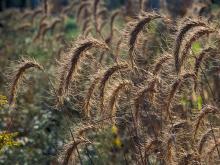
Species Types
Scientific Name
Elymus canadensis
Description
Canada wild rye can be identified by its bristly seed heads, which curve downward. As the seeds mature, the straight, long awns curve and bend. This is a common native cool-season grass that reaches about 4 feet tall and is highly valued as forage and hay for livestock.
Media
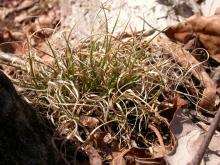
Species Types
Scientific Name
Danthonia spicata
Description
A common sight in dry upland Ozark woods, poverty grass is a species you can identify by its leaves alone. The basal leaves persist for several years, becoming dry and curly. Although the flowering stems can be 2 feet high, the basal leaves are only about 5 inches long.
Media
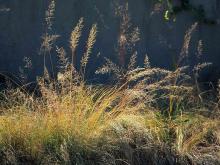
Species Types
Scientific Name
Sporobolus heterolepis
Description
Prairie dropseed is a native perennial bunch grass that forms dense clumps of fine, light green, arching leaves. The seed heads are airy, open, branching clusters bearing small, ovate florets on their own individual branchlets.
Media

Species Types
Scientific Name
Hexalectris spicata (syn. Bletia spicata)
Description
Crested coral root is an orchid that lacks chlorophyll, so none of it is green. It obtains nutrients from fungi and decaying organic matter. Compared to our other coral roots, it is taller and has larger flowers. It grows in Ozark habitats.
Media
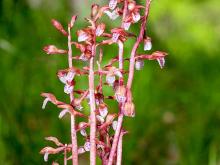
Species Types
Scientific Name
Corallorhiza wisteriana
Description
Spring coral root blooms in April and May. Except for a few small sheathing bracts along the stem, it has no leaves. The purplish or brownish flowers are in a raceme at the tip of the stem. Each flower’s lower lip is white with purple markings.
Media

Species Types
Scientific Name
Buchnera americana
Description
American bluehearts is a single or few-stalked wildflower of prairies and glades. It has distinctive, showy purple flowers that turn black as they age.
Media
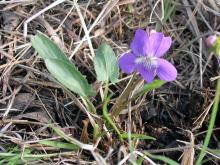
Species Types
Scientific Name
Viola sagittata
Description
Arrow-leaved violet, or arrowhead violet, is a native Missouri perennial spring wildflower that grows in prairies, glades, and woodland openings. It has distinctive arrowhead-shaped leaves.
Media

Species Types
Scientific Name
Phlox pilosa
Description
Downy phlox, also called prairie phlox, is a perennial wildflower with lance-shaped leaves and showy, rounded clusters of pink or lavender flowers. It is similar to blue phlox, but it grows more often in prairies and other open, sunny, and drier habitats.
See Also
About Wildflowers, Grasses and Other Nonwoody Plants in Missouri
A very simple way of thinking about the green world is to divide the vascular plants into two groups: woody and nonwoody (or herbaceous). But this is an artificial division; many plant families include some species that are woody and some that are not. The diversity of nonwoody vascular plants is staggering! Think of all the ferns, grasses, sedges, lilies, peas, sunflowers, nightshades, milkweeds, mustards, mints, and mallows — weeds and wildflowers — and many more!





















